- Joined
- Feb 15, 2012
- Messages
- 4,700
- Reaction score
- 3,395
Some of the info that I have been posting for years here:
Have fun and enjoy watching!
The information in the video isn't really to "condemn" or "hate" LEDs, but to show some of the facts of both technologies.
There is no argument, really!
I've been posting all that since loooong ago.
Halides are the best representation of natural sunlight.

Have fun and enjoy watching!
The information in the video isn't really to "condemn" or "hate" LEDs, but to show some of the facts of both technologies.
There is no argument, really!
I've been posting all that since loooong ago.
Halides are the best representation of natural sunlight.
Last edited:






















